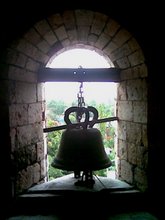 Formerly called Catmon, Santa Barbara was made an independent parish in 1760 under the advocation of Santa Barbara Virgin y Martir. The present religious structure was built in 1855 and was finished in 1878.
Formerly called Catmon, Santa Barbara was made an independent parish in 1760 under the advocation of Santa Barbara Virgin y Martir. The present religious structure was built in 1855 and was finished in 1878.
Under the Tuscan Order, the facade is given a baroque drift by graceful broken arches and ornate finials. The three-storey affair of the facade is brought by an extravagant and excessive use of cornices and niches.
 The convent of Santa Barbara is the cradle of Iloilo's Revolutionary government since it was made the headquarters of Gen. Martin Delgado, who struggled the odds to free Iloilo from the grasp of the Spaniards. It was successfully restored on the town's 220th anniversary. The convent is an example of Moorish architecture. A design commonly seen in Southern Spain. Today, both the church and the convent are declared as National Heritage Sites.
The convent of Santa Barbara is the cradle of Iloilo's Revolutionary government since it was made the headquarters of Gen. Martin Delgado, who struggled the odds to free Iloilo from the grasp of the Spaniards. It was successfully restored on the town's 220th anniversary. The convent is an example of Moorish architecture. A design commonly seen in Southern Spain. Today, both the church and the convent are declared as National Heritage Sites. 
1 comment:
This is about the country’s flag and the town of Santa Barbara, Iloilo.
On March 25, 1936, President Manuel L. Quezon. Issued E.O. No. 23 prescribing the technical description and specification of the Filipino Flag. It was followed by other directives assigning the National Historical Institute as the authority in Philippine Vexillaries and Heraldry.
Gordon's proposed bill adding yet another ray to the Philippine flag should concern all Filipinos but most especially us Ilonggos.
The eight rays within the white triangle represent the towns within Luzon that fathered the Philippine Revolution.
However, Santa Barbara, which actively participated under General Delgado, was never represented in the flag.
Gordon and even Puentebella maintain that Muslim resistance to colonial rule merits a ray. Problem is, Mindanao is already one of three stars that mark our flag.
Whatever for is this bill? It begs a timely answer- acknowledge the " Cry of Santa Barbara" in it's proper context.
Omon Maravilla
omonmar@yahoo.com
Post a Comment